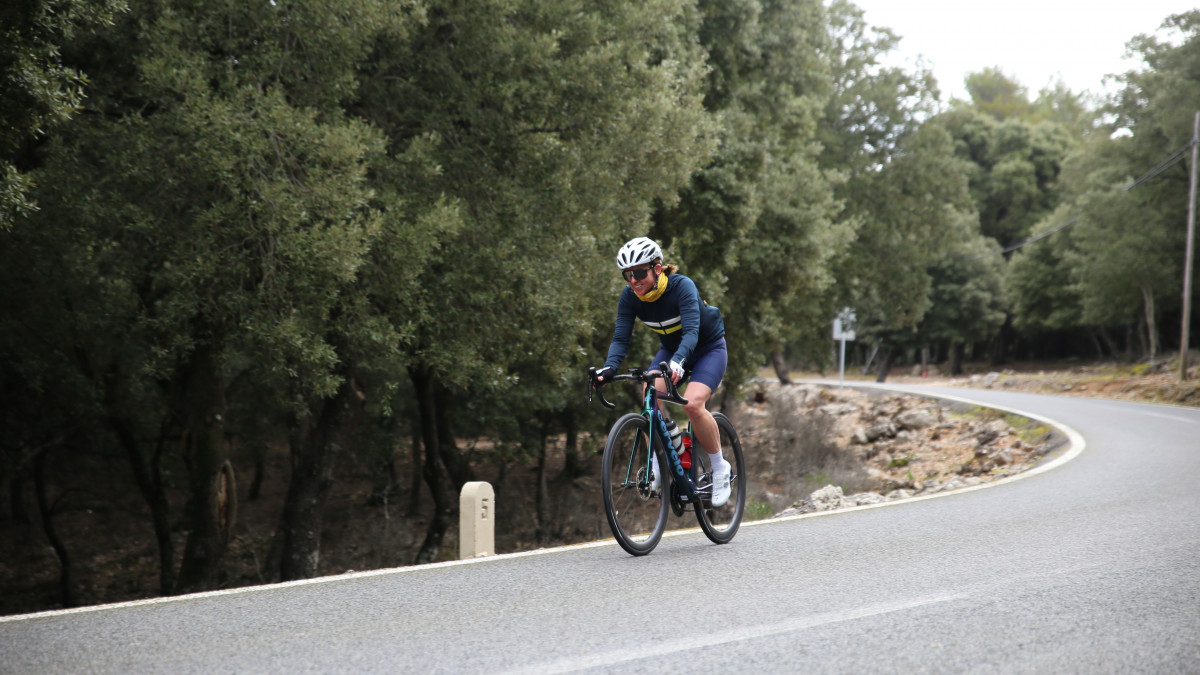8 TOP TIPS TO DESCENDING FAST, SAFELY AND EFFICIENTLY

Developing your descending skill is essential for your overall cycling proficiency.
What goes up, must come down.
Descending on a bike can be great fun, but it can also be quite nerve-wracking if you're not used to it. Getting downhill fast and safely is an essential cycling skill but one that can often be overlooked.
You may not want to race down mountains and the sight of Tom Pidcock flying down an alpine descent might send shivers down your spine. Or you might be tackling a big ride like the Etape or Marmotte where efficient descending is essential to getting a good time and good recovery between climbs.
Either way, mastering the art of downhill cycling is crucial for every cyclist. Here are our eight top tips for getting down fast, safely, and efficiently, so you can confidently tackle descents.

Before You Start: Ensuring Bike Trust and Safety
Before you even start, it is essential to be able to trust your bike! Knowing your tyres are in good condition and at the correct pressure, as well as your brakes working well, will make a big difference to your mental confidence when descending.
Make sure you do the Njinga Bicycle Safety M-Check before leaving your house. And always remember to wear your helmet for maximum safety.
Descending with Confidence
Remember that the more you practise, the better you become, so every time you find yourself going down a hill, think of ONE of the aspects below, remain mindful, and be connected to the process.

1. Look Ahead
It's vital to keep your head up and look forwards as far ahead as possible. Constantly remind yourself to keep your 'chin up' to maintain good visibility and awareness of the road ahead.
2. Gear Selection
Select a high (hard) gear in case pedalling is required during the descent. This will ensure you have the necessary power and control when you start to turn the pedals again. Often cyclists are still in a low gear from the climb and forget to change over, causing them to spin out on the descent.

0px

3. Review the Road Ahead
Assess the length, surface conditions, gradient, and visibility of the descent. Also, be mindful of any potential obstacles or hazards on the side of the road. Be particularly careful of shaded areas as it's hard to clearly see any holes or bumps which could unbalance you at speed.
4. Hand Placement
Hold your handlebars at the widest part and keep your brakes covered all the time, with two fingers on the brake levers. If you have a road bike, descending on your drops (the curly bits of your handlebars) lowers your centre of gravity, providing better stability. If you don't feel confident, start with your hands on the brake hoods and work your way down to getting onto your drops.


5. Body Position
Adopt the 'ready position' with pedals parallel to the ground and put as much weight through your pedals as you can. Lift your bottom slightly off the saddle, shifting your weight back, which lowers your centre of gravity and improves stability.
6. Braking
Control your speed by applying the brakes gently or feathering them on longer downhills. Remember to keep your brakes covered all the time. Always brake before any corner to reduce your speed gradually. Be aware that hard braking moves your body forward as the bike slows down, so brace yourself through your pedals to maintain balance. Use your front brake sparingly, applying both brakes evenly.


7. Cornering While Descending
Remember your cornering skills. Brake before the corner, inside leg up, look through the corners, lean your bike to turn, and ride that perfect line. Smooth and controlled cornering is crucial for maintaining stability and control.
8. Road Position
Avoid hugging the edge of the road when descending. It is safer to use the road, especially when riding at higher speeds. By taking a more central position, you reduce the risk of cars overtaking you while you're descending.
Additionally, it prevents you from fixating on a car's bumper if they are slower, allowing you to maintain focus and ride confidently.

Practising descending is the only way to build confidence and improve, so consider dedicating specific sessions to fine-tune these techniques. Or book a 1:1 session with our coaches for a faster learning curve.
Ride with a purpose, either with a friend who shares the same goals as you, or on your own for focused training. This way, you can make the most of your time and continually improve your descending skills.
Descending on a bike requires a combination of technique, confidence, and a focus on safety. By following these tips and practising the suggested skills, you can enhance your ability to descend with speed, control, and efficiency.
Remember to always prioritise safety by ensuring your bike is in optimal condition and wearing proper protective gear. So gear up, embrace the challenge, and enjoy the thrill of descending like a pro, or at the very least a confident amateur!
Ride safe, have fun, and happy descending!
For more great tips and training support, check out our Njinga Cycling Academy our immersive online training platform. Think of Netflix for cyclists with expert, online coaching, anytime, anywhere. It's like having a personal cycling coach in your pocket.
Categories: : Ride Smart

SIGN UP TO OUR NEWSLETTER
and access our FREE Stretching video series.
Includes: dynamic PRE-ride, static POST-ride, and restorative DEEP stretching routines, ensuring you start to feel the benefits immediately.
 Njinga Cycling
Njinga Cycling 
